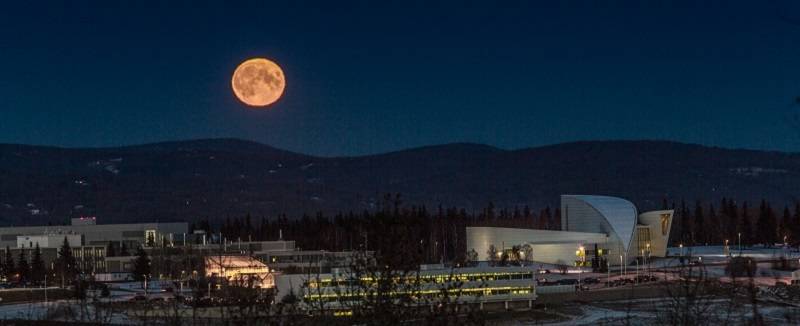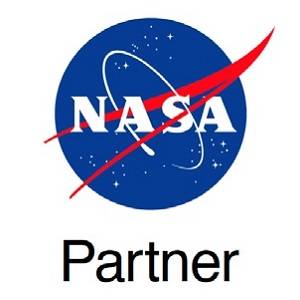Astronomy Calendar
Check out what's happening in the sky!
This calendar of celestial events is frequently updated.

Image: UAF photo by Todd Paris, 2014.
Discover the Sun during the Heliophysics Big Year, October 2023 to December 2024!
The Heliophysics Big Year is a global celebration of solar science and the Sun’s influence
on Earth and the entire solar system. Learn more: NASA Helio Big Year.
- March 13 - Full Moon. The Moon will be located on the opposite side of the Earth as the Sun and its face will be fully illuminated. This phase occurs at 10:56 pm Alaska time. This full moon is sometimes known as the Worm Moon, the Crow Moon, the Crust Moon, the Sap Moon, and the Lenten Moon.
- March 14 - Total Lunar Eclipse. A total lunar eclipse occurs when the Moon passes completely through the Earth's dark shadow, or umbra. During this type of eclipse, the Moon will gradually get darker and then take on a rusty or blood red color. The eclipse will be visible throughout all of North America, Mexico, Central America, and South America. (NASA Map and Eclipse Information)
- March 20 - March Equinox. The March equinox occurs at 12:58 am Alaska time. The Sun will shine directly on the equator and there will be nearly equal amounts of day and night throughout the world. This is also the first day of spring (vernal equinox) in the Northern Hemisphere and the first day of fall (autumnal equinox) in the Southern Hemisphere.
- March 29 - New Moon. The Moon will located on the same side of the Earth as the Sun and will not be visible in the night sky. This phase occurs at 3:00 am Alaska time. This is the best time of the month to observe faint objects such as galaxies and star clusters because there is no moonlight to interfere.
- March 29 - Partial Solar Eclipse. A partial solar eclipse occurs when the Moon covers only a part of the Sun, sometimes resembling a bite taken out of a cookie. A partial solar eclipse can only be safely observed with a special solar filter or by looking at the Sun's reflection. This partial eclipse will be visible throughout Greenland and most of northern Europe and northern Russia. It will be best seen from Canada with 93% coverage. (NASA Map and Eclipse Information)
- April 12 - Full Moon. The Moon will be located on the opposite side of the Earth as the Sun and its face will be fully illuminated. This phase occurs at 4:24 pm Alaska time. This full moon is sometimes known as the Pink Moon, the Sprouting Grass Moon, the Growing Moon, the Egg Moon, and the Fish Moon.
- April 21 - Mercury at Greatest Western Elongation. The planet Mercury reaches greatest western elongation of 27.4 degrees from the Sun. This is the best time to view Mercury since it will be at its highest point above the horizon in the morning sky. Look for the planet low in the eastern sky just before sunrise.
- April 22, 23 - Lyrids Meteor Shower. The Lyrids is an average shower, usually producing about 20 meteors per hour at its peak. It is produced by dust particles left behind by comet C/1861 G1 Thatcher. The shower runs annually from April 16-25. It peaks this year on the night of the night of the 22nd and morning of the 23rd. These meteors can sometimes produce bright dust trails that last for several seconds. The thin crescent moon will not pose much of a problem so this should be a good show. Best viewing will be from a dark location after midnight. Meteors will radiate from the constellation Lyra, but can appear anywhere in the sky.
- April 27 - New Moon. The Moon will located on the same side of the Earth as the Sun and will not be visible in the night sky. This phase occurs at 11:32 am Alaska time. This is the best time of the month to observe faint objects such as galaxies and star clusters because there is no moonlight to interfere.
- May 6, 7 - Eta Aquarids Meteor Shower. The Eta Aquarids is an above average shower, capable of producing up to 60 meteors per hour at its peak. Most of the activity is seen in the Southern Hemisphere. In the Northern Hemisphere, the rate can reach about 30 meteors per hour. It is produced by dust particles left behind by comet Halley. The shower runs annually from April 19 to May 28. It peaks this year on the night of May 6 and the morning of the May 7. The waxing gibbous moon will block out some of the fainter meteors this year. But if you are patient, you should still should be able to catch a some of the brighter ones. Best viewing will be from a dark location after midnight. Meteors will radiate from the constellation Aquarius, but can appear anywhere in the sky.
- May 12 - Full Moon. The Moon will be located on the opposite side of the Earth as the Sun and its face will be fully illuminated. This phase occurs at 8:57 am Alaska time. This full moon is sometimes known as the Flower Moon, the Corn Planting Moon, and the Milk Moon.
- May 26 - New Moon. The Moon will located on the same side of the Earth as the Sun and will not be visible in the night sky. This phase occurs at 7:04 pm Alaska time. This is the best time of the month to observe faint objects such as galaxies and star clusters because there is no moonlight to interfere.
- May 31 - Venus at Greatest Western Elongation. The planet Venus reaches greatest eastern elongation of 45.9 degrees from the Sun. This is the best time to view Venus since it will be at its highest point above the horizon in the morning sky. Look for the bright planet in the eastern sky before sunrise.
Information from Sea and Sky Astronomy Calendar.
More astronomy viewing resources:
Check the aurora forecast for Interior Alaska, courtesy of the Geophysical Institute.
Explore the Aurora Tracker from Explore Fairbanks.
Use star wheels and astrolabes to find celestial bodies!
Sea and Sky has a yearly calendar to help you plan future astronomy viewings.
Check the weather on Mars, courtesy of the Curiosity rover.

Image: Perseids Meteor Shower (NASA/JPL).

This project was funded under NASA cooperative agreement NNX16AL65A and cooperative agreement number NNH15ZDA004C. Any opinions, findings, and conclusions or recommendations expressed in this material are those of the author(s) and do not necessarily reflect the views of the National Aeronautics and Space Administration.
